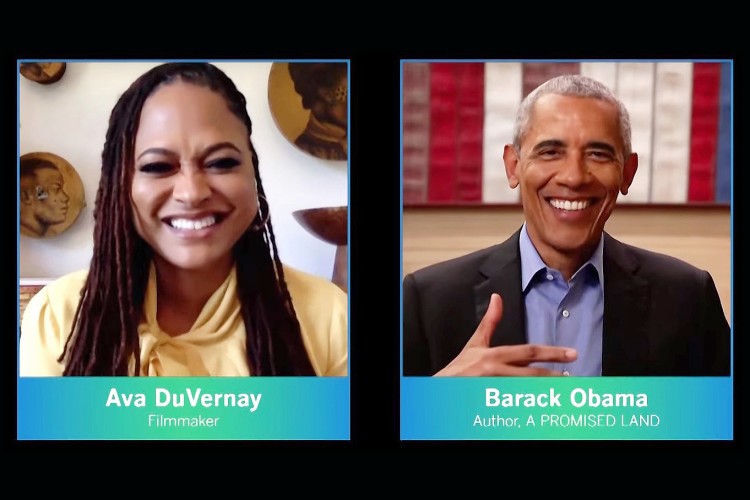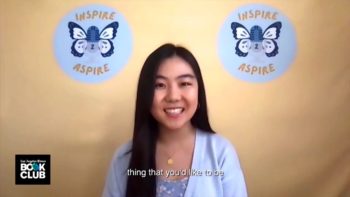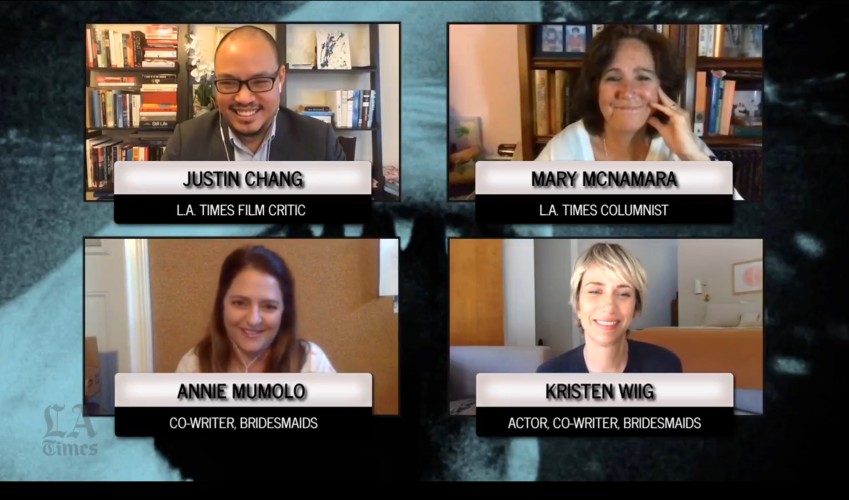How the Los Angeles Times built a compelling series of virtual events during the COVID-19 pandemic
Samantha Melbourneweaver and Donna Wares, The Los Angeles Times,This is a series on Better News to a) showcase innovative/experimental ideas that emerge from the Knight-Lenfest Newsroom Initiative and b) share replicable tactics that benefit the news industry as a whole. This “win” comes from Samantha Melbourneweaver, audience engagement director, and Donna Wares, Book Club editor, both of the Los Angeles Times, which participated in the Major Market Table Stakes program in 2019.
Learn more about their virtual events on the “It’s All Journalism” podcast.
Question: What communities do you serve and what can you tell us about the history of your organization?
Answer: The Los Angeles Times was founded as a local, daily newspaper in 1881. We’re still a daily newspaper that serves Southern California and have been online since 1996. Our coverage is concentrated on Los Angeles and California, and our digital audience is similarly concentrated in our local community, extends across the West Coast and into other parts of the country and the world where people have a connection to or interest in what happens here. We’re in the Los Angeles DMA and see the 88 cities in Los Angeles County as the communities we serve.
Question: What problem were you trying to solve, and why was solving the problem strategically important for your organization?
Answer: The Los Angeles Times has a long history of putting on successful in-person events including the annual Festival of Books, which draws more than 150,000 people every spring, and our two-year-old L.A. Times Book Club, which hosts monthly conversations with leading authors and newsmakers. Before the pandemic, all book club events were paid, ticketed events at local venues and had turned the corner on being profitable.
But when the pandemic hit, we had to cancel all of our events — which total about 90 each year. We knew people were sitting at home, doom-scrolling and looking for a way to connect in a non-scary way. Right away we noticed that some of our most popular non-coronavirus stories were about how to spend the time in quarantine: what shows to watch, what books to read and how to develop new cooking skills. So we wanted to offer something lighter, easier to get into and just useful to our readers.
Q: How is this approach related to Table Stakes (e.g. one of the 7 Table Stakes and/or an outgrowth of the Knight-Lenfest initiative, etc.)?
A: This effort is tied to Table Stake No. 2 (Publish on the platforms used by your targeted audiences), No. 5 (Diversify and grow the ways you earn revenue from the audiences you build) and No. 7 (Drive audience growth and profitability from a “mini-publisher” perspective).

Filmmaker Ava DuVernay interviewed former President Barack Obama about his memoir “A Promised Land” during an L.A. Times Community Book Club event in April. (Courtesy of the Los Angeles Times)
Q: How did you go about solving the problem?
A: We just got to work. This was a scenario we really didn’t overthink and we added to our process and team along the way.
Initially, as the pandemic shutdowns began across California, we just needed to keep the L.A. Times Book Club going. Donna had already arranged for a great discussion about L.A. Noir with two bestselling authors, and we wanted to keep that date. She reached out to our in-house video staff and the crew that works on our daily TV show with Spectrum News 1, “L.A. Times Today,” and she enlisted their help to make the event happen via Zoom.
Sam was there to promote the event and to chat with readers in real-time to dig up questions we could share with the authors. After working on that first wild show (the bassett hounds really stole the night), Sam and Donna realized there was some magic in this format and started brainstorming other “shows” that we could put together using our own video and reporting staff.

High schooler Grace Lee asked a question of former President Barack Obama during the April event. (Courtesy of the Los Angeles Times)
And thus, our skunk works team for virtual events was born. We sprinted to put on as many events as we could handle using existing staff and a little elbow grease. We moved our popular community book club to virtual events and made it easy for readers to join discussions with authors such as Viet Thanh Nguyen, Brit Bennett, Alice Waters and, recently, Barack Obama.
We also created new virtual experiences including the “Ultimate Summer Movie Showdown” (readers chose the weekly movie to watch and discuss); “We Can Teach You That” (a skills series with Times staffers and outside experts); and “Ask a Reporter” (adapted from a feature of our in-person events for timely conversations that take readers behind the headlines and even inside the paper’s 2020 election endorsements).
During the pandemic, we decided to offer many events, including book club conversations, for free as a public service to connect with readers and build our audiences. The Times also charges for some virtual events, including the established Ideas Exchange series and a variety of hybrid streaming and dine-at-home events. For the new expert series, “We Can Teach You That,” we charged for some sessions and offered a deep discount to subscribers; for example, WCTYT classes are $20, but just $10 for subscribers.
The goal was always to maintain our excellent live events, offer readers an extra service and learn how to generate revenue through ticket sales or sponsorships for events even when we can’t convene in person. We want to get people talking while making the newspaper more than something to read every day. We are creating something to experience. Something that brings us together.
We built on the vision and experiences of the L.A. Times Book Club, which focuses on stories and authors relevant to Southern California and the West — books that illuminate and explain our unique landscape, culture, identity and history. Every month we host conversations to explore such topics as immigration and entertainment, food and travel, criminal justice and technology, sports and social issues.
The book club is always about much more than the books. For example, in June 2020 we were reading “The Compton Cowboys,” about the little-known history of Black cowboys in Southern California, when protests erupted across L.A. in the wake of George Floyd’s murder. The real-life cowboys led a peace ride to protest police abuses through the city and drew thousands to join them.
Our book club conversation the following week with author and journalist Walter Thompson-Hernandez and Times assistant managing editor Angel Jennings became a timely community forum on race, survival and social justice. We opened book club night with a news video of the peace ride. More than 30,000 viewers watched the discussion, which is available at latimes.com and featured in a follow-up story.
Our events feature a mix of well-known guests, newsmakers, Times staffers and SoCal experts such as Thompson-Hernandez, who have a deep connection to the subject and the community. That relevance and a guest’s willingness to answer reader questions are the key ingredients of every successful event we’ve hosted.
As we developed ideas, our advertising and marketing teams reached out to find ways to partner and bring in sponsors and encouraged us to expand our virtual offerings.
Our virtual events have attracted sponsors such as health care companies and a national liquor brand. Our advertising team is working to find more sponsors and build a more consistent revenue stream.
But for many virtual events the primary goal is community service and building trust. Some recent examples include: Ask a Reporter events on L.A. schools reopening and the rise of anti-Asian violence, and community forums on the Chicano Moratorium and our June 24 event, Local Matters: How to Survive the Big One, in partnership with KPCC public radio. These are important community conversations that have grown from Times coverage and our commitment to cover, explain and reveal L.A.’s diverse communities.

Bridesmaids star Kristen Wiig and co-writer Annie Mumolo joined L.A. Times film critic Justin Chang and Times columnist Mary McNamara during the “Ultimate Summer Movie Showdown.” The movies featured during the 16-week series were chosen by readers. (Courtesy of the Los Angeles Times)
Q: What worked?
A: Consistency! Though we’ve added teammates and collaborators across the org and varied topics, we’ve largely kept our initial format — a staffer hosts, a special guest Zooms in from home and we solicit and answer reader questions. We sprinkle in images, graphics and video — visuals from our related coverage — to make the shows more interesting and professionally done. It’s been important that everyone knows what to expect.
Related content: In addition to preview materials created to promote events, we feature author interviews, book excerpts and other stories in advance of book club talks. We did the same thing for our 16-week “Ultimate Summer Movie Showdown.” Our movie critics revisited the favorite films Times readers chose each week and then we invited top talent, such as Mission: Impossible director Christopher McQuarrie and Bridesmaids star Kristen Wiig, to join the discussion.
For “Ask A Reporter” or “We Can Teach You That” events, we are building on existing staff work that’s been popular among readers. Those stories then become another avenue for readers to find out about and sign up for our events, and signal the breadth of our organization’s offerings. We really want people to see a compelling photo on our site and think, “Wow, I loved that! I wish there were more — OMG, they are having an event with this photographer, and I can submit a question!” And that’s happening.
Transparency: From the start, we’ve been intentionally vocal within the newsroom and with our readers about what we’re building. We’re constantly seeking and receiving feedback and ideas about how to improve, and we also keep working with new collaborators who bring fresh ideas and resources. For events, we follow up with surveys and ask readers: What will you take away from this event? What could we do better? What would you like next time? The response has been overwhelmingly positive with requests for more.
Q: What didn’t work?
A: Well, we were inventing this as we went along, but every wrong turn was a learning experience. One of the first things we learned: Nobody likes a daytime event. Not even during a pandemic. Also, cute titles don’t make sense to people. That’s a big reason our “masterclass” event series has such a straightforward name: “We Can Teach You That.” A boring host or a nervous guest can really tank the show. A flexible host is a must-have.
Q: What happened that you didn’t expect?
A: The biggest surprise has been that our audience really, really wants to go deep. Especially when we bring in newsroom staff for events, our audience comes early, stays late and asks tough, important questions. For instance, one of the most-attended events was a panel discussion with a few of our Black reporters about what it was like to cover the racial justice protests and pandemic as a Black journalist. It was an intense and cathartic conversation for our reporters and for our viewers, and hopefully showed how reachable and authentic we are in everything we do.
Q: What would you do differently now? What did you learn?
A: We’ve learned that readers are hungry for conversations that help them make sense of this tumultuous time. They don’t want just a passive reading experience. They want to connect and be part of the conversation. They want a deeper discussion on issues that matter to their community.
We’ve also learned to do a better job keeping events tight and focused. No one wants to stick around on Zoom much longer than an hour.
Q: What advice would you give to others who try to do this?
A: Start small and build as you go: Even if you have the resources to do a full-on TV production, you probably don’t need it. Look at the stories people read and create your events around those topics.
We took readers inside the COVID wards through Francine Orr’s photography from the start of the pandemic. We hosted “Black Poets in a Time of Unrest” with eight poets sharing their views of the city at this moment through verse. We talked about our city’s long history of racism against Asians with pop culture icon George Takei recounting how his family was forced from their L.A. home to live in the horse stables at Santa Anita during World War II.
Share a link to a Zoom webinar and invite people in as participants. Try out a live conversation on Clubhouse. Really hone your format before you add the bells and whistles of streaming to multiple platforms and bringing in tons of guests. Keep it simple. Don’t try to squeeze in too many people or topics. People are more than happy to watch two people talk for an hour, as long as they address the issue they said they’d explain.
Plan and rehearse: We create a “run of show” for each event, which outlines every piece of the show but isn’t quite as specific as a script, and we distribute it to everyone involved. It’s our simple roadmap for everything, from when to bring guests on screen to when to share images, videos and links to stories. Then, just ahead of the event, we do a full run-through to shake out the jitters and cut out anything that doesn’t work. Planning is essential when team members are all working in different locations.
Make it easy to find: For virtual book club events, we create a “how to watch” post at latimes.com so readers can view free events live on their platform of choice, YouTube, Facebook or Twitter, or tune in later if they missed it.
We do that for two reasons. First, it makes it easy for readers to join book club events at their convenience and to share an evening they’ve enjoyed with others. Secondly, it boosts our viewing numbers, especially in the 24 hours after the event.
Our most-viewed event was the April book club with Barack Obama (more than 100,000 views). Other timely events without celebrity guests also have drawn strong viewership. For example, our “Ask A Reporter” event with Black staffers, our Chicano Moratorium forum and our Black poet event all drew more than 39,000 viewers.
Q: Is there anything else you’d like to add?
A: We listen to our community of readers and adapt. No two events are the same, and we constantly change how we produce events. We know that in a few months we’ll be doing all this differently. We’re already talking about hybrid events — events that will allow people to attend in person and also offer a virtual experience so readers still can join us from home without fighting the L.A. traffic.
The biggest challenge is always producing revenue from events, and we are still working on sponsorships and other revenue options. This summer, we also are expanding our established fiscal sponsorship relationship with the local community foundation to help fund the long-term growth of our book club, literary programs and other community-minded initiatives. For the book club and community forums, our goal is to build a mosaic income including ticket sales, sponsorships and grants to keep virtual and in-person events accessible to all who want to join us.
More on events:
- How Scalawag is using events to diversify audience and grow membership
- Events are extremely difficult. You should do them anyway.